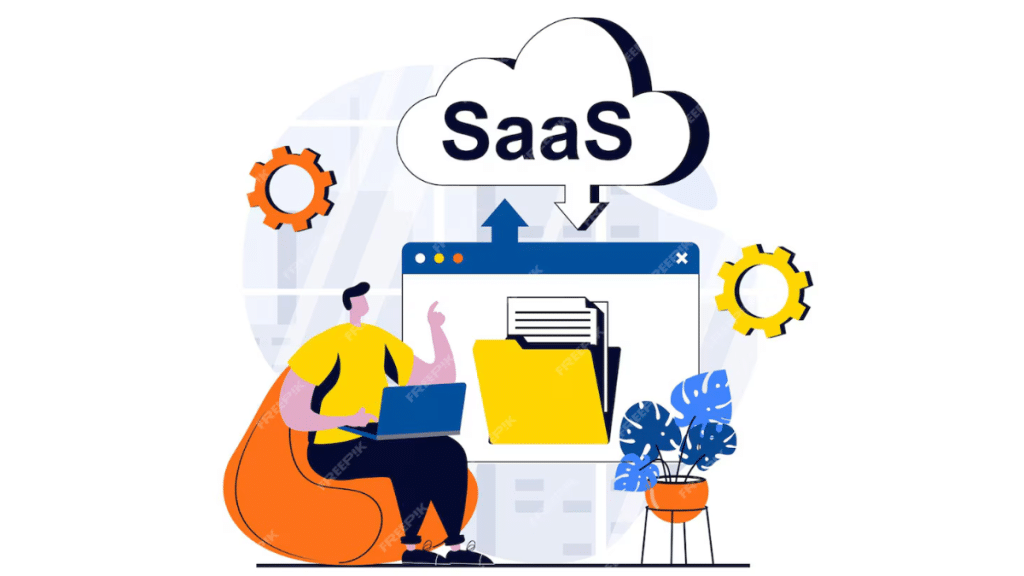Self-experience of the Australian business itself towards digital transformation has provided the turbo-charged boost over the last two or three years propelled by growing customer pressure, worldwide competition, and the growing need of responsiveness and innovation.
Software-as-a-Service (SaaS) is one among the key drivers of an evolution like that. But to best leverage SaaS, business leaders need to have a handle on the underlying architecture that makes it all possible. Well-designed SaaS architecture is the secret to future-proof, scalable, and secure solutions.
This article describes how Australian businesses need to consider the most important things and strategic recommendations when implementing or refreshing their SaaS strategy.
Understanding SaaS Architecture
SaaS application architecture, in the most basic sense, is the supporting infrastructure and organization behind making SaaS applications work. Unlike locally installed software, these applications are hosted in the cloud and accessed over the internet. A well-structured architecture is essential for delivering dependable SaaS solutions that offer benefits like automated updates, reduced infrastructure costs, and effortless scalability. However, the overall effectiveness still depends on how well the system is architected.
Well-designed SaaS architecture allows organizations to provide intuitive user experience, adaptability to match evolving business needs, and robust data security.
Among them are multi-tenancy, microservices, containerization, API connections, and sound DevOps discipline. Each piece understanding how each piece works guarantees the SaaS implementation has room for plans to support enterprise-grade growth.
Scalable SaaS Architecture Key Components
Multi-Tenant Design
Multi-tenancy enables a single software deployment to serve many customers, or tenants, without their data being aggregated. The architecture supports optimization and management of the resources in a simple manner. A multi-tenant SaaS model is inexpensive for Australian businesses to implement and enables quicker deployment. The architecture supports service providers to roll out updates and improvements to all tenants at once and maintains solutions current with minimal human effort.
Microservices and APIs
New SaaS architecture adopts microservices—a software design pattern as a collection of loosely connected services. Microservices are communicated between themselves using APIs, and it is simpler to replace, change, or add scale to an application without affecting the whole system. Australian businesses which need to innovate at pace will adore the flexibility and modularity of microservices. APIs likewise make it simpler for external platform and service integration, enabling companies to build integrated digital ecosystems.
To support rapid prototyping and early validation, MVP software development services play a pivotal role in this process. They allow Australian businesses to launch lean versions of their SaaS solutions with just the core features, gather real user feedback, and iteratively improve the product based on real market needs—reducing risk and enhancing time-to-market effectiveness.
Elastic Infrastructure
Elastic infrastructure enables SaaS systems to scale resources automatically in accordance with the users’ load. Cloud hosting of services like AWS, Google Cloud, or Azure enables the organizations to enjoy the advantages of dynamic provisioning of the computing capacity and storage capacity. This feature ensures avoidance of failure in performance in case of traffic surges, with reduced downtime, and maximum efficiency in operations.
Security and Compliance
Security must be baked into SaaS infrastructure. That entails in-flight encryption as well as encrypting at-rest data, role-based authentication, and support for standards like ISO 27001 and GDPR. Australian businesses must conform to the regional law that is the APPs in Australia. Aggressive auditing, threat analysis, and incident response protocols must be in place so that risk is mitigated and faith with consumers is developed.
High Availability and Disaster Recovery
Companies need to make their SaaS applications highly available, especially if they are the center of mission-critical business processes. These are load balancing, on-the-fly backup, and globally distributed data centers to avoid business disruption due to outages. Documented disaster recovery plan ensures rapid return to function in case of failures with business continuity assured.
Strategic Benefits of SASS Design
Improved Agility
With SaaS-designed architecture, business organizations can deploy updates and new functionality on time without crippling downtime. This is vital to business survival in today’s rapidly evolving Australian market landscape. They can react quickly to marketplace feedback and changing business priorities due to CI/CD-enabled agile development cycles.
Cost Optimization
Through shared infrastructure and economies of scale, SaaS architecture minimizes hardware and software maintenance costs to negligible levels. This allows companies to reallocate thus saved funds towards innovation and core business processes. Efficient operation is also facilitated through subscription pricing, with cost predictability and stops massive upfront capital outlays.
Improved Customer Experience
Efficiently executing SaaS software produces frictionless experiences, increased speed of load, and bulletproof performance. Loyal customers are most likely to remain, bring in others, and leave word-of-mouth recommendations for ongoing improvement. Customer-driven design, real-time support feature, and monitoring of performance enable companies to make their solutions specifically tailored for the best interaction.
Data-Driven Decisions
SaaS products generally possess analytics and reporting features through which companies can mine operating, performance, and user behavior trends and behavior for insights. These are used in strategic planning and decision-making. Companies also utilize the machine learning and artificial intelligence capabilities integrated into certain SaaS products for predictive analysis and trend forecasting.
Ease of Integration
Due to modular structures and standardized APIs, SaaS applications are simple to integrate into existing applications and third-party platforms. This provides a seamless digital experience for organizations. A digital transformation company can play a crucial role in facilitating these integrations, ensuring that automation is achieved, human intervention is minimized, and compatibility across departments is maximized—ultimately enabling end-to-end business processes.
Challenges Australian Businesses Need to Overcome
Legacy System Integration
Most mature Australian companies continue to adhere to older software packages less than optimally compatible with newer SaaS providers. Unraveling integration problems requires a hybrid solution and perhaps sequential rollout. IT professionals must seriously examine compatibility issues and employ middleware or APIs to circumvent system limitations with minimal disruption.
Vendor Lock-In
Choosing the incorrect SaaS provider will result in dependence, and changing to another platform will be time- and expense-intensive. Businesses must accord high priority to those providers that are open standards and offer simple exit strategies. Testing of the service-level agreement (SLA), data portability, and contract flexibility is necessary to avoid long-term captivity.
Customisation vs. Standardisation
Although SaaS products do possess generic solutions well-liked by a vast majority, particular Australian businesses may require specific functionality. Standardization has to exist alongside customization so that things are neither made less efficient and redundant. Customization needs to be undertaken with care so that versioning concerns and increased complexity in maintenance are not created.
Data Residency Concerns
Data sovereignty is a very critical issue to the governments or the regulated industries. The companies should ensure their SaaS providers satisfy Australian data residency requirements. Using service providers having hosts within Australia or hosting by using both in-house and host-in-country ensures such issues and is compliant.
Change Management
The shift to a SaaS model is cultural and change-driven. Employees would need new technology skills training, and business processes may need to be re-engineered to accommodate the SaaS delivery model. Leadership, communications, and stakeholder management are critical success drivers.
Best Practices for SaaS Architecture Implementation
Perform a Readiness Assessment
Prior to migrating into a SaaS platform, find out your organization’s IT maturity level, digital ambitions, and existing infrastructure. This will assist in deciding on appropriate applications for migration and handling the risks involved. An accurate readiness plan serves as a blueprint for successful conversion.
Select the Right SaaS Solutions for Australia
Not all SaaS providers are identical. Australian business requires providers that have local Australian presence or provide wide regional coverage. Choosing tailor-made SaaS solutions in Australia secures compliance with Australian regulations and attention to local market requirements. Local presence guarantees best localization and faster problem solution.
Emphasis on User-Centric Design
Engage end-users throughout the development process so that the final product is end-user-friendly. Collect feedback regularly and update functionalities in real-time usage. Good user experiences are built with personalization, accessibility, and natural interfaces.
Invest in DevOps and Automation
By using DevOps practices, ongoing monitoring, testing, and deployment are possible. Human mistakes are minimized by means of automation, and performance gets improved, so SaaS structure becomes stronger. Enterprises need to implement infrastructure-as-code, container orchestration, and CI/CD pipelines in order to provide automatic deployment.
Regularly Update Security Protocols
Cyber threats evolve every day, and so should your security controls. Continuously review security practices and plug loopholes at the same time to protect customer information and business reputation. Cybersecurity awareness and incident response training for employees also reduces risks.
Create SLAs and Governance Models
Specific Service Level Agreements (SLAs) outline responsibility and performance. Models of governance require compliance, risk management, and business strategy alignment. Good governance promotes transparency, stakeholder confidence, and policy adherence.
Future of SaaS in Australia
The Australian SaaS industry will grow manyfold in the next couple of years. Growing need for digitalization and friendly regulation offer a green field to companies to shape SaaS products. New technologies such as AI embedding, low-code/no-code, and edge computing have the power to reshape the future of SaaS development.
Besides, with more Australian scale-ups and start-ups joining the SaaS market, opportunities for local providers will be growing. This can offer co-innovation as well as customized solutions to address local requirements. Further investment in digital infrastructure and skills will keep driving SaaS adoption.
Conclusion
For Australian companies to expand successfully, finding and employing good SaaS architecture is not a choice but a necessity. Although quick cost savings and operations victories are tempting, good SaaS architecture creates the foundations for innovating, scaling at speed, and seizing long-term competitive advantage. Architecting with scalability, security, and integrational readiness allows companies to future-proof their digital strategy and unleash unprecedented value for customers in an era of growing cloud-first adoption.
Author Name : Bhumi Patel
Author Bio : Bhumi Patel has vast experience in Project Execution & Operation management in multiple industries. Bhumi started her career in 2007 as an operation coordinator. After that she moved to Australia and started working as a Project Coordinator/ Management in 2013. Currently, she is the Client Partner – AUSTRALIA | NEW ZEALAND at Bytes Technolab – a leading product engineering company australia, where she works closely with clients to ensure smooth communication and project execution also forming long term partnerships. Bhumi obtained a Master of Business Administration (MBA) in Marketing & Finance between 2005 and 2007.
Author Headshot:


